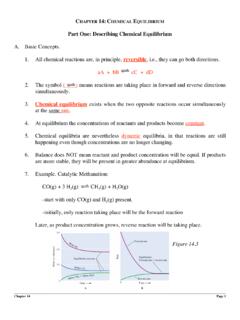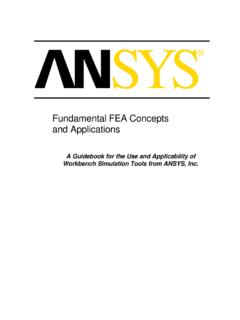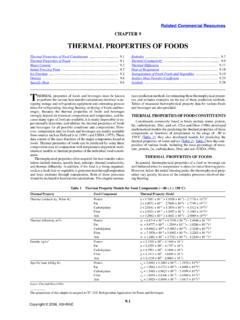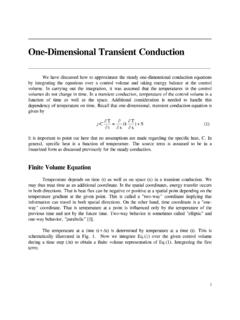Transcription of Chapter 2 HCS12 Assembly Language - TTU CAE Network
1 Chapter 2. HCS12 Assembly Language ECE 3120. Dr. Mohamed Mahmoud outline Assembly Language program structure Arithmetic instructions Branch and loop instructions Shift and rotate instructions Boolean logic instructions Bit test and manipulate instructions Assembler directives - Commands to the assembler - Not executable by the microprocessor are not converted to machine codes - Define program constants and reserve space for dynamic variable - Specifies the end of a program. 2-1. 1. end - Ends a program to be processed by an assembler - Any statement following the end directive is ignored 2.
2 Org (origin). - Tells the assembler where to place the next instruction/data in memory - Example: org $1000. ldab #$FF ;this instruction will be stored in memory starting from location $1000. 3. (define constant byte), db (define byte), fcb (form constant byte). - Define the value of a byte or bytes that will be placed at a given location. - Example: 800 $11. org $800 801 $22. array $11,$22,$33,$44 802 $33. 803 $44 2-2. 4. (define constant word), dw (define word), fdb (form double bytes). - Define the value of a word or words that will be placed at a given location. 800 $AC. - For example: 801 $11.
3 Org $800 802 $F1. array $AC11,$F122,$33,$F44 803 $22. 804 $00. 805 $33. 806 $0F. 807 $44. 5. fcc (form constant character). - Tells the assembler to store a string of characters (a message) in memory. - The first character (and the last character) is used as the delimiter. - The last character must be the same as the first character. - The delimiter must not appear in the string. - The space character cannot be used as the delimiter. - Each character is represented by its ASCII code. 2-3. - For example: msg fcc Please enter your name: . Org $1000 1000 $64. 1001 $65. Alpha fcc def 1002 $66.
4 - Assembler will convert to Ascii 6. fill - Fill a certain number of memory locations with a given value. - Syntax: fill value, count - Example: space_line fill $20, 40. ; fill 40 bytes with $20 starting from the memory location referred to by the label space_line 7- ds (define storage), rmb (reserve memory byte), (define storage bytes). - Reserves a number of bytes for later use. - Example: buffer ds 100. reserves 100 bytes starting from the location represented by buffer - none of these locations is initialized 2-4. 2-5. 8. (define storage word), rmw (reserve memory word). - Reserve a number of words Dbuf 20 ;Reserves 20 words (or 40 bytes) starting from the current location counter.
5 9. equ (equate). - Assigns a value to a label. - Makes programs more readable. - Examples: loop_count equ 50. Informs the assembler whenever the symbol loop_count is encountered, it should be replaced with the value 50. 2-6. Example 1: Array of bytes Example 2: Array of words 2-7. Example 3: Two dimensional arrays This computation is done by assembler Later, we will write a code to read one and two dimensional arrays 2-8. A line of an Assembly program Label field - Labels are symbols defined by the user to identify memory locations in the programs and data areas - Optional - Must starts with a letter (A-Z or a-z) and can be followed by letters, digits, or special symbols (_ or.)
6 2-9. Label field - Can start from any column if ended with : . - Must start from column 1 if not ended with : . - Example: Begin: ldaa #10 ; Begin is a valid label Print jsr hexout ; Print is a valid label jmp begin ; do not put : when referring to a label 2 - 10. Comment field - Optional - Explain the function of a single or a group of instructions - For programmer not for assembler or processor. - Ignored by assembler and are not converted to machine code. - Can improve a program readability - very important in Assembly - Any line starts with an * or ; is a comment 2 - 11.
7 - Separated from the operand and operation field for at least one space Instructions Instructions - Instruct the processor to do a sequence of operations - Converted to machine code - Operands follow the opcode and is separated from the opcode by at least one space - Operands are separated by commas - Opcode is the operation and separated from the label by at least one space - Assembler instructions or directives are not case sensitive 2 - 12. - Must not start at column 1. Software Development Process 1. Problem definition: Identify what should be done 2. Identify the inputs and outputs 3.
8 Develop the algorithm (or a flowchart): - Algorithm is the overall plan for solving the problem at hand. - Algorithm is a sequence of operations that transform inputs to output. - An algorithm is often expressed in the following format (pseudo code): Step 1: read a value and store in variable X.. Step i: N= X + 5.. 4. Programming: Convert the algorithm or flowchart into programs. 5. Program Testing: - Testing for anomalies. - Test for the max. and min. values of inputs 2 - 13. - Enter values that can test all branches outline Assembly Language program structure Arithmetic instructions Branch and loop instructions Shift and rotate instructions Boolean logic instructions Bit test and manipulate instructions - Zero flag (Z): set when the result is zero - Negative flag (N): set whenever the result is negative, , most significant bit of the result is 1.
9 - Half carry flag (H): set when there is a carry from the lower four bits to the upper four bits. - Carry/borrow flag (C): set when addition/subtraction generates a carry/borrow. - Overflow flag (V): Set when the addition of two positive numbers results in a negative number or the addition of two negative numbers results in a positive number. whenever the carry from the most significant bit and the second most significant bit differs 1010 1010. + 0101 0101 C = 0, V = 0, Z = 0, N = 1. 1111 1111 2 - 14. 2 - 15. Overflow Problem: fixed width registers have limited range Overflow occurs when two numbers are added or subtracted and the correct result is a number outside the range that can a register hold Overflow Detection 1- Unsigned numbers: Overflow occurs when C = 1, C flag can be considered as a bit of the result.
10 2- Signed numbers: Overflow occurs when V = 1. Overflow cannot occur when adding numbers of opposite sign why? If there is an overflow, then the given result is not correct 1111 1111 Signed numbers: -1 +1 = 0 , no overflow and the result is + 0000 0001 correct 0000 0000 Unsigned numbers: 255 +1 = 256, overflow, 256 needs 2 - 16. C =1, V =0 9 bits instead of 8, the result is incorrect Addition: C = 1, the result needs more space than the register width V = 1, (+ve) + (+ve) = (-ve) or ( ve) + (-ve) = (+ve). Subtraction: A - B. There is no unsigned overflow but there is signed overflow C = 1, when there is a borrow or B > A.







